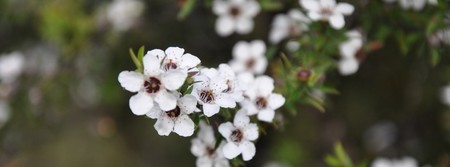Manuka as a tree crop
Kiwis have grown up with mānuka honey and tea tree oil but these humble household items are fast becoming a multi-million dollar forest industry for New Zealand.
Overall honey exports were $242m in 20151, having grown about 23% a year for the past decade, likely due to the specific demand for mānuka honey. Scion is currently working with the Bay of Plenty Regional Council to help deliver the Bay of Connections regional growth strategy for the wider Bay of Plenty, with a vision of creating a prosperous region supported by sustainable sectors. This complements the work being undertaken by the High Performance Manuka Plantations Primary Growth Partnership (PGP) programme. The PGP programme is led by Mānuka Research Partnership Limited, partnering with the Ministry for Primary Industries.
Forest scientist and interim coordinator for the Council’s mānuka action plan, Bob Shula, says the industry currently relies on native stands to supply the growing demand for mānuka. “The majority of these stands will mature naturally and transition to kānuka after about 25 years, creating uncertainty around the supply of pure raw material. This is likely to restrict investment and expansion.”
Bob says the first step is to generate a sustainable supply of mānuka as a plantation species or nurse crop to mainstream forestry species.
“Manuka offers an opportunity to boost regional growth, especially for rural and Māori communities where land can be leased to apiarists. For example, we are working with East Coast iwi to identify land suitable to grow mānuka for honey and oil. We are also working with industry partners to develop high performing mānuka cultivars so growers can have more control over the quality of the final product.”
Soil scientist Dr Simeon Smaill says there are many unknowns around plantation mānuka. “We are seeing what we can apply from past research with other exotic and indigenous species in addition to work we’re doing with mānuka. The aim is to move from wild harvest to science based farming by combining improved genetics with best management practice.
”Hedging for oil production could provide a secondary income stream, but it’s not known if this can be combined with honey production. There is also the myrtle rust threat to address, so integrating resistance into breeding programmes is fundamental to the future of this industry. This work is part of the wider programme to establish sustainable, resilient and productive plantations.”
Deciding where those plantations are best grown is what Research Leader Melissa Evans is working on.
“We’ve developed a prototype analysis framework called Finding Opportunities for Resilient Manuka (FORM), in partnership with East Coast iwi and other partners to assess the feasibility of growing mānuka for oil. The FORM framework assesses where plantations could be placed, where existing wild stands are growing, the costs of harvesting and distillation, and the total worth of the value chain.
“From this, we’ve created a series of maps specific to the East Coast that show the potential value of mānuka oil production. Our next step is to progress FORM as a stand-alone mānuka assessment tool incorporating both oil and honey production.”
Principal Technologist Graham West has been integrating mānuka economics into MyLand, a web-based model that provides a framework for long term land-use planning, with economic and environmental outputs over time.
“We collate the output from specialised farming or cropping models to give whole property cash flows while considering environmental and practical implementation constraints. The framework can create scenarios using pastoral farming, forestry and mānuka on the various geophysical blocks within a property. This makes it possible for landowners to compare options and make informed decisions about what to plant, and where, for the long term future.”
1 ANZ. (2015, Oct). Agri Focus.

